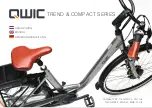
ENJOYING YOUR BELTER EVERY RIDE
Your Early Rider Belter is uniquely designed to be low maintenance but it will still benefit from care and attention.
CLEANING
Cleaning your bike regularly means you are more likely
to notice any loose or worn components and possible
frame damage. A clean, well lubricated bike will also run
more smoothly.
We recommend using a bicycle or car shampoo, a sponge
and a brush. Wash, rinse and dry before lubricating it.
DO NOT JET WASH
as this may damage your bike’s
cartridge bearings.
LUBRICANTS
NOTE:
Your bicycle uses a belt to drive the sprockets
and not a chain. Your belt does not require lubrication.
Lubricating your belt will only attract dirt in the same
way a chainset does.
After cleaning your bike, it is advisable to spray with a water
dispersant, let it dry and then lubricate key pivot points.
Brake arms, brake levers and brake cables are all
components that benefit from lubrication. Your wheels
have sealed cartridge bearings and will run without
maintenance however it is worth periodically checking the
condition of the bearings by spinning the wheels and
making sure they are running freely and smoothly.
simple maintenance
BELT TENSIONING
Unlike a chain your belt will not suffer from stretching,
meaning no reduction of performance. Occasionally however,
you may need to tension the belt, for example after having
repaired a puncture. Tensioning the belt is made very simple
with ‘tensioners’ located in the front of the rear dropouts on
either side (between the chain stay and seat stay).
To tighten the belt loosen the four dropout-plate bolts (A),
loosen the lock nuts on the tensioner screws (B), and turn
the belt tensioner adjustment screws using a 3mm allen key
clockwise as shown right. Alternate adjusting the left and
right belt tensioners to ensure the rear wheel remains aligned
centrally with the frame of the bike. Your belt should have
no more than 20mm vertical movement when pressed in the
middle point of the drive train. Do not over-tighten the belt
as this will affect performance. Turn the pedals/cranks and
watch to ensure the belt is running correctly centred on the
front and rear sprocket.
If for example the belt is running too far to the right on
the rear sprocket then turn the right tensioner adjustment
screw clockwise or the left tensioner screw anti-clockwise
dependant on what is required to maintain optimum belt
tension. Once correct alignment and tension have been
achieved tighten all four drop-out plate bolts to 6nm,
re-check alignment and then secure tensioner screw
lock nuts.
B
A





























